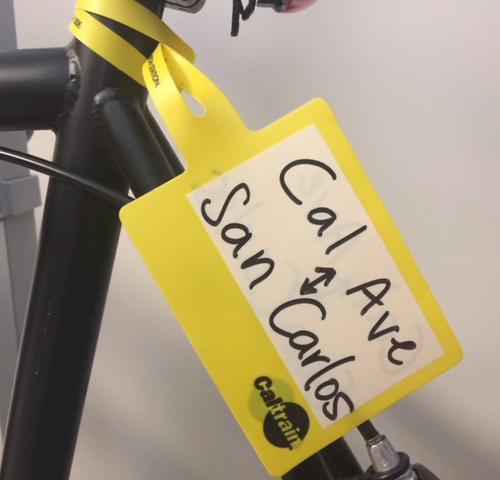Caltrain has one of the most popular bicycle onboard programs in the nation. Riders with bicycles are encouraged to park bikes at Caltrain stations or use bike share when feasible.
To meet the needs of riders with bicycles Caltrain has increased the number of on-demand eLockers, now available at most stations offering safe, secure and easy bicycle parking.
Bike Destination Tags
-
Cyclists should prominently display bike destination tags to indicate where they are getting off the train.
-
Bike tags help cyclists stack bikes in an organized manner by destination.
-
Riders can request a tag from the conductor or create one (PDF) and attach it to their bike in a place that can be easily seen by others.

Bike Destination Tag Example
Rules & Guidelines
General
- The conductor, at their discretion, may decline transportation or revise the handling of bicycles/scooters due to crowded trains, or other considerations.
- Bikes/scooters are not allowed to be locked to the train.
- There is no additional charge to bring a bicycle/scooter on board.
Platform
- For safety reasons, bicycles/scooters cannot be taken on escalators and must not be ridden in station buildings, on platforms or ramps.
Loading/Unloading
- Customers with bicycles must lift and maneuver their own bicycle onboard the train without assistance from conductors.
- Passengers with bicycles board first on bike cars.
- In order to reduce delays, the first cyclists boarding should move in as far as possible so other customers with bicycles have space to board the train.
- Stack bikes by destination so everyone has access when unloading their bike.
Bicycle Types
- Bicycle stalls vary in length. All bicycles must fit in designated space (71”) without protruding into the aisle.
- Gas-powered, tandem or three-wheel bicycles are not allowed.
- Training wheels, detachable or collapsible trailers or large, bulky attachments which expand bicycle width, such as saddlebags, baskets, backpacks or briefcases, are not allowed.
- Bicycles must have no protrusions which could cause injury or damage.
- Bicycles must be kept clean and free of excessive dirt and grease.
Folding Bikes
- Folding bikes are allowed on any train car as long as they are no wider than 32 inches at the widest point.
- Folding bikes must be in the folded position prior to boarding and must remain under the control of the owner while on board.
- Folding bikes must be able to be stored under the seat.
- Folding bikes may not be placed on seats and must not block aisles, stairs or vestibules.
- Folding bikes may not be stored in the space reserved for passengers wheelchairs.
- Folding bikes that are not in the bike rack must remain folded until the passenger has fully left the train.
Note: Caltrain may alter the rules/guidelines at any time, as necessary.
Liability
Cyclists are legally responsible for any damage to the train's equipment, other bikes and for any injury to other passengers or train personnel as a result of the cyclist's negligence.
Caltrain is not responsible for any theft or damage to bicycles while on the train.
Train Types & Bikes
Caltrain currently has two types of trains:
- Electric trains have two bike cars and are limited to 36 bikes per bike car (72 bikes total per train)
- Bombardier trains (South County service) are equipped with one bike car.








.svg)